Knowing the cost of an iguana is a crucial first step if you’ve ever thought about bringing one home. This article will explore the many elements that go into iguana purchasing prices, including significant elements like species, age, and size.
We’ll also explore the basic materials needed to furnish your scaly companion’s home and make it feel like their natural habitat.
We offer tips on purchasing essential items such as large enclosures, customized lighting, and heating systems. We’ll also explain the ideal diet and basic care your iguana needs to maintain good health and happiness.
With that said, let’s take a tour into the fascinating world of iguana ownership, whether you’re a seasoned reptile enthusiast or an eager newbie!
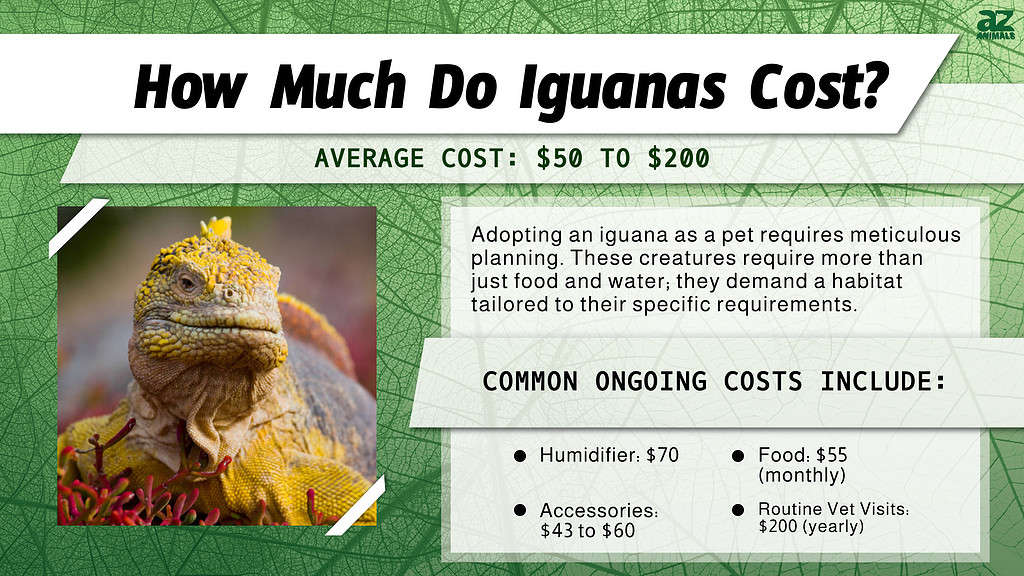
Scaling Up: The Reality of Owning an Iguana
Iguanas are intriguing inhabitants of the Central and South American rainforests. They exist in varied colored tones, such as green, blue, or red and yellow, which makes them highly admirable among animal enthusiasts worldwide.
Adopting an iguana as a pet requires meticulous planning. These creatures require more than just food and water; they demand a habitat tailored to their specific requirements.
It should mimic their natural habitat as closely as possible and provide ample space for movement.
Ensure you monitor humidity levels to avoid dehydration; aim for levels between 60 – 80%. You should also install artificial light (UVB lamps or basking light) and heat in your iguana’s enclosure. The ideal temperature should fall between 85°F – 95°F, which is similar to temperatures in tropical rainforest climates. Iguanas are herbivorous animals that mostly feed on kale or collard green stems but occasionally eat fruit.
Above all else, consider if your lifestyle allows you to give your scaly friend adequate attention before deciding to adopt an iguana. To meet the financial obligations related to iguana ownership, evaluate your financial capacities and create a well-structured budget. By taking into account these key elements, you can be sure that you are ready to commit the necessary time and money to meet your iguana’s needs and promoting a happy and rewarding relationship.
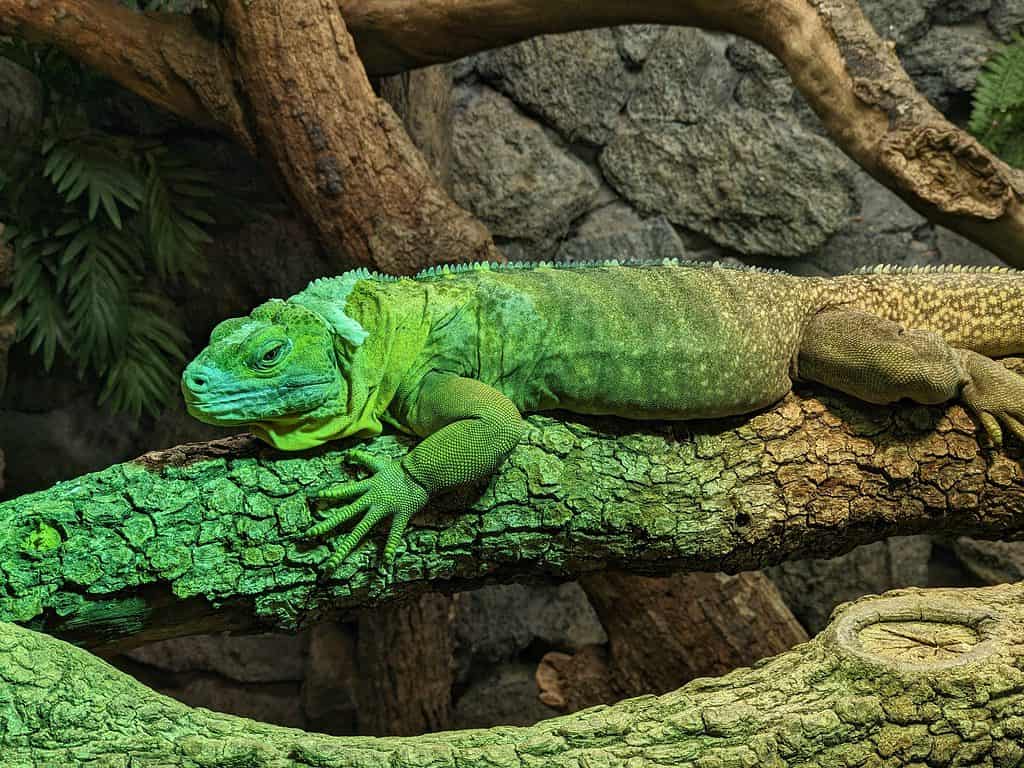
Monitor humidity levels (60-80%) and provide artificial light and heat (UVB lamps or basking light) in your iguana’s enclosure to prevent dehydration.
©Flanker_ct/Shutterstock.com
Benefits of Owning an Iguana
Adopting an iguana offers far more than meets the eye, transcending the mere costs associated with ownership. Unlike passing trends in an oversaturated market, the companionship of an iguana endures, creating a lasting bond that goes beyond superficial appeal.
Moreover, their undeniable charm adds an extra layer of adorableness to the equation. By choosing to welcome an iguana into your life, you’re not only investing in a unique and enduring relationship, but you’re also embracing a captivating companion whose charm goes beyond fleeting fads.
With that said, here are three reasons why you shouldn’t think twice about getting an iguana as a pet:
1. They’re Easy to Maintain
Iguanas are remarkable creatures that bring unparalleled companionship to their owners. These spiny species can live up to 20 years with proper care. As a low-maintenance companion, Iguanas don’t need to be walked, nor do they demand constant attention and human interaction, making them great pets to keep at home.
2. They’re Attractive
Owning an iguana may offer artistic value if you aim to expand your art collection. Their bright colors and distinct shapes are well suited for creating eye-catching living arrangements, unexpectedly framing your room’s atmosphere.
Sit back and witness the captivating spectacle of your extraordinary scaly companion as they navigate their habitat, engaging with various objects and stimuli. Whether they are basking lazily on a sun-kissed rock or indulging in a delectable feast of greens, their actions provide an endless source of entertainment.
From their curious exploration to their delightful interactions, there is never a shortage of amusement when observing the antics of your unique scaly friend.
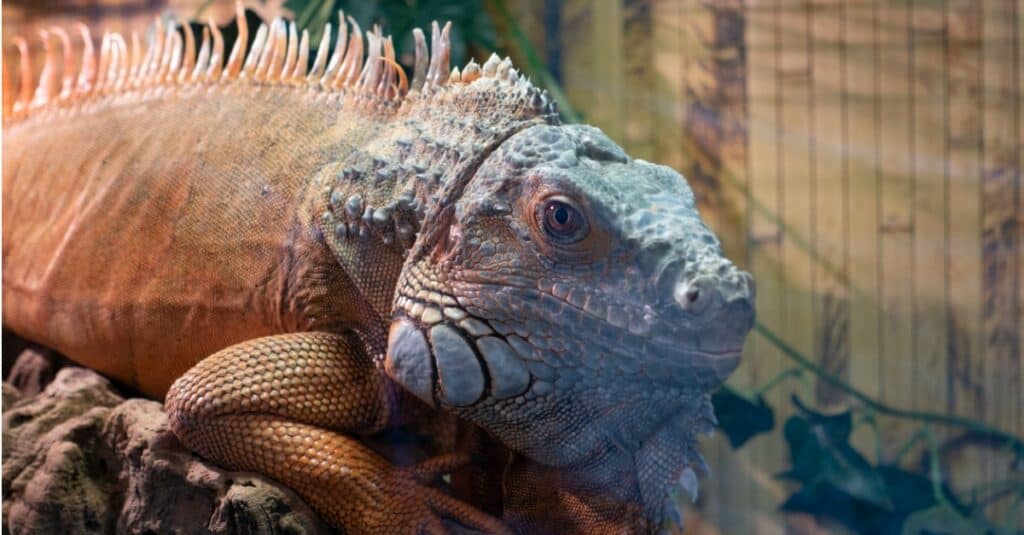
Iguanas’ vibrant colors and unique shapes make them perfect for creating visually striking living arrangements that enhance the atmosphere of any room.
©iStock.com/Chepko
3. We Can Learn A Lot From Them
Aside from being pretty companions, iguanas offer educational value for children or adults, either by teaching responsibility towards caring for another organism or learning about the natural reptile habitats, which sends out a clear message of conservationism.
The Cost of Owning an Iguana
While these prehistoric lizards may seem like an exciting addition to your family, it’s crucial to be aware of the financial responsibilities of owning one. Costs can add up quickly, from getting the iguana to purchasing its substrates/food, humidifiers, and temperature/humidity gauges, as well as settling vet visits.
Owning an iguana requires you to invest in their health and well-being, which comes at a considerable cost.
The Ultimate Guide to Purchasing Healthy and Affordable Iguanas
Iguanas are available for purchase at local pet stores or online reptile markets. They range between $50‒$200 depending on their size and species. When purchasing your new scaled friend, choose a reputable seller; ensure they have a good reputation for nurturing and breeding healthy reptiles.
Opting for a healthy iguana with a long lifespan surpasses the temptation of impulsively selecting the first adorable critter you encounter at the store. It is crucial to observe certain indicators such as regular eating and drinking habits, as well as proper shedding of their skin, which enables their continuous growth while maintaining a vibrant and colorful appearance.
Additionally, vibrant energy levels are essential, indicating a robust and thriving iguana. When approaching them, they should emanate positive vibes, displaying enthusiasm instead of retreating or moving sluggishly, which could be warning signs of underlying health issues. Prioritizing these factors ensures that your chosen iguana is in good health, promising a fulfilling and enduring companionship.
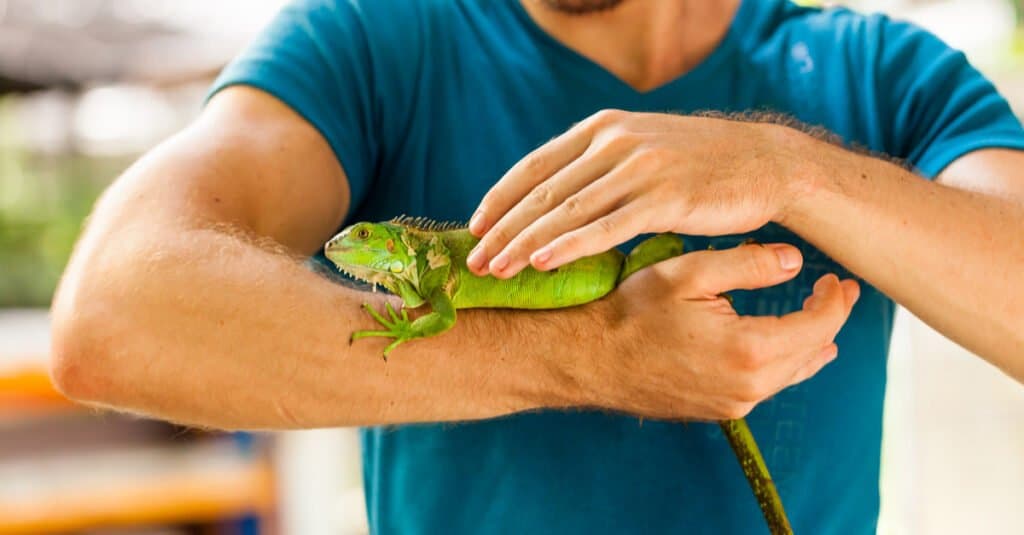
Choosing a healthy iguana with a long lifespan is better than impulsively selecting the first adorable one.
©Cocos.Bounty/Shutterstock.com
Buying Commercial Substrates
When it comes to owning an iguana, the substrate plays a vital role as it covers the floor of their cage or habitat. Its significance goes beyond aesthetics; one of its primary functions is to absorb and contain your iguana’s waste. However, not just any substrate will do. It should be selected carefully, considering both functionality and cost-effectiveness, because we all want our beloved pets to be comfortable without breaking the bank.
Many pet stores offer prepackaged substrates that are conveniently precooked and sanitized, typically priced around $35. If you’re looking for more affordable alternatives that still work effectively, you can get creative by using bunny or rabbit pellets available at farm supply stores nationwide, ranging in price from approximately $10 to $20 per bag, depending on quality. Rest assured, opting for economical choices like this won’t compromise your lizard’s physical health as they will thrive even with alternative options.
Feeding your Iguana Like a Pro without Breaking the Bank
Ensuring optimal nutrition for your iguana can present an enjoyable challenge. While a plethora of fancy food products line the shelves for these adorable reptiles, splurging on them might not necessarily support their well-being optimally.
Thankfully, there are affordable methods to uphold a well-rounded and nutrient-packed diet for our scaly companions. By incorporating budget-friendly options such as collard greens, mustard greens, and spinach, we can provide our reptile friends with a plethora of essential nutrients from leafy green vegetables. Combining nutrient-packed vegetables like Zucchini, peas, green beans, and carrots further enhances their meals without breaking the bank.
For their favorite fruits, blueberries, blackberries, apples, and pears offer delightful diversity in texture and taste, adding an affordable and fun aspect to their diet. Surprisingly, iguanas even enjoy grains such as pasta, rice, and bread. While their dietary needs may vary based on factors like size and location, there’s no need to overspend. Allocating a reasonable sum of $20 is sufficient to cater to your tiny pet’s dietary requirements.

Adding nutrient-rich vegetables such as zucchini, peas, green beans, and carrots can enhance their meals without overspending.
©iStock.com/Mladich
The Cost of Veterinary Care Demystified
Owning an iguana can be a truly rewarding experience, but it also entails responsibilities like any other pet. While they may not require as much attention as dogs or cats, proper veterinarian care is essential, and it’s important to consider this when evaluating iguana costs. When acquiring your scaly companion, it is highly recommended to schedule a comprehensive physical examination to ensure their well-being from the outset. Additionally, it is crucial to provide your iguana with at least one annual check-up.
During veterinary visits, various tests and analyses are typically conducted alongside the physical exam. For instance, fecal analysis is performed to check for parasites, costing approximately $15-$20 twice a year. Radiological tests are conducted annually to detect tumors, masses, or enlarged organs.
Blood tests, skin scrapings, and microbiological tests are also potential procedures to identify issues like yeast or abnormal bacteria that could lead to serious infections. The initial visit alone can cost around $50, while fecal checks are generally priced at approximately $15-$20 per examination twice a year. On average, annual veterinarian care for iguanas amounts to over $200 per year.

Regular annual check-ups are essential to maintain your iguana’s health and ensure their ongoing care.
©agus fitriyanto suratno/Shutterstock.com
Breathe Easy: The Benefits of Using a Humidifier for Your Iguana
For our scaly companions, who love the hot, muggy weather, it’s crucial to establish a comfortable and healthy atmosphere at home. Using a humidifier is a fantastic way to achieve this. A high-quality humidifier can significantly improve your iguana’s comfort and assist with any respiratory issues they may be experiencing.
It’s like giving them their own little piece of paradise right in your home! However, it’s essential to strike a balance as excessive humidity can lead to bacterial or fungal growth. To avoid this, consider investing in a humidifier with control options like a timer and Humidistat, typically found in high-end models.
When considering purchasing a humidifier, keep in mind that prices may vary but often remain within the affordable range of “Iguana Prices.” Spending around $70 for a quality humidifier is a worthwhile investment, as it can potentially save you money on medication or treatment costs by maintaining your pet’s respiratory hygiene.
The benefits of owning a humidifier extend beyond comfort and respiratory support; it also plays a crucial role in your little friend’s long-term health. Therefore, be wise in your choice when buying. With proper usage and maintenance, a top-notch humidifier ensures there are no limits to keeping your iguana happy and thriving throughout the year.
Other Accessories
Aside from providing necessities like food, water, and shelter, here are a few other items you’ll need for your iguana:
1. UVB Bulb
Iguanas are native to tropical regions where they bask in sunlight for several hours each day. If you want to replicate this environment in captivity, providing UVB lighting for them is a worthy option. UVB bulbs come in different sizes depending on the size of your tank and can cost anywhere from $17 to $30. The light from these bulbs will help your iguana synthesize vitamin D3, that’s crucial for bone health.

The UVB light aids in the synthesis of vital vitamin D3, promoting strong bone health for your iguana.
©iStock.com/Marina Vedernikova
2. Heat Bulbs
While UVB bulbs are essential for your iguana’s growth and development, heat bulbs also play a vital role as they help create a basking spot within the enclosure. Iguanas need temperatures ranging from 80-95 degrees Fahrenheit during the day and approximately 70-75 degrees Fahrenheit during the night.
Iguanas lounge under warm lights since their bodies can’t regulate temperature through sweat glands. Providing ample floor space is extremely important in their vivarium/terrarium. They’re available at relatively low prices, usually about $14 for two.
3. Temperature Gauge
If left unattended, high or low temperatures can negatively affect your iguana. Monitor your heat lamps closely by investing in a quality temperature gauge. These helpful devices range between $12 to $15 and can help you monitor the temperature in your enclosure and ensure that it is kept within safe levels.
Budget-friendly Iguana Care: Tips and Tricks for Smart Savings
You should closely consider the costs of taking care of your new iguana. But don’t panic; there are numerous methods of cutting costs without sacrificing your iguana’s health; all it requires is consistency and deep thought. Here are some pointers:
1. Do Your Research
Before purchasing any supplies or equipment, thoroughly research what is necessary for your iguana’s well-being. Going in unprepared can lead to unnecessary purchases. Make sure to list everything you need and stick to it.
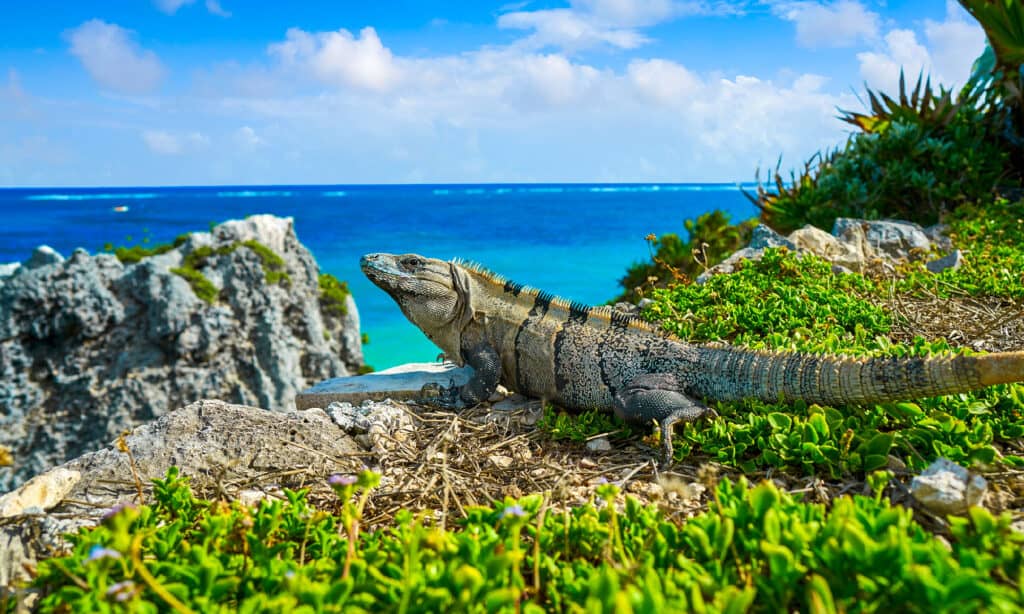
Prioritize thorough research on the essential supplies and equipment needed for your iguana’s well-being.
©iStock.com/LUNAMARINA
2. Buy in Bulk
When buying food items such as fruits, vegetables, and crickets (or mealworms), buy them in bulk rather than individually packed containers which come at an inflated rate.
3. Ensure Proper Waste Disposal
Ensure proper waste disposal mechanisms – cleaning cages and throwing away wasted food will not only keep the environment clean but also prevent unwanted diseases from spreading, thus saving on vet bills.
4. Buy Second-Hand Products
Consider purchasing second-hand products. Nailing high-quality second-hand heating lamps and UVB bulbs is always an option for those looking to cut costs.
5. DIY projects
Look out for DIY home-made flooring or climbing structures, which can be cheaper alternatives providing ample space to climb rocks etc.
6. Create an Annual Budget
Creating a budget that includes veterinary visits, vitamins/mineral supplements, UVB lamp replacement bulb bulbs, and emergency arrangements would sensibly cover unexpected costs and allow one to plan toward expenditure management.
Embracing the Joy of Owning an Iguana: Managing Costs and Creating Memorable Experiences
Iguana ownership may be an incredibly fulfilling experience that is well worth the time and money commitment. Despite the high expenditures, these creatures can be affordable with good planning and budgeting. It’s important to explore cost-saving options such as using bunny pellets instead of expensive prepackaged substrates or considering second-hand equipment.
Not only do iguanas bring an exotic touch to your home, but they also offer educational value and teach responsibility towards other living beings. So, don’t let the initial cost deter you. Embrace the joy of owning an iguana and create unforgettable memories today.
The photo featured at the top of this post is © iStock.com/USO
Thank you for reading! Have some feedback for us? Contact the AZ Animals editorial team.







